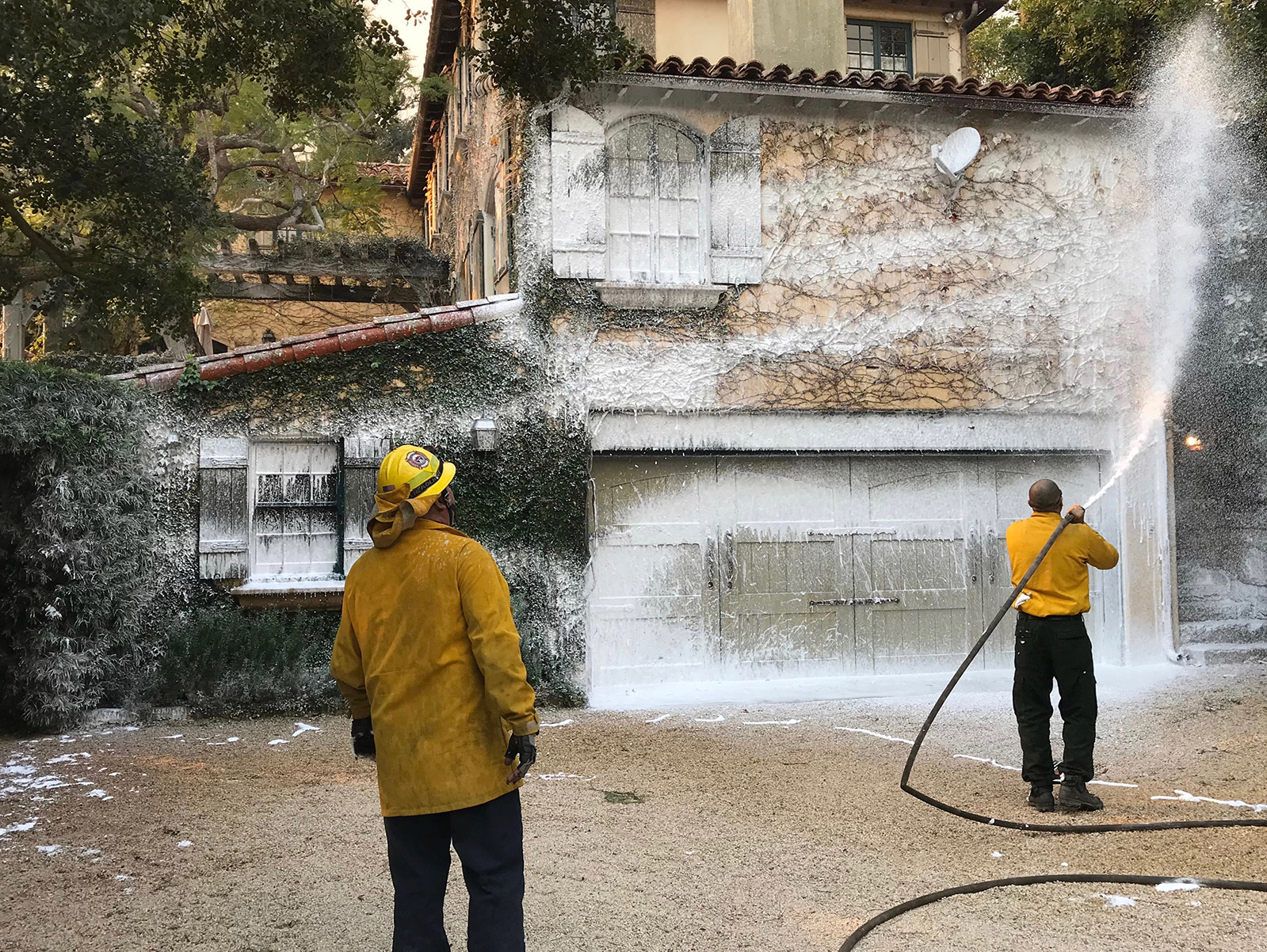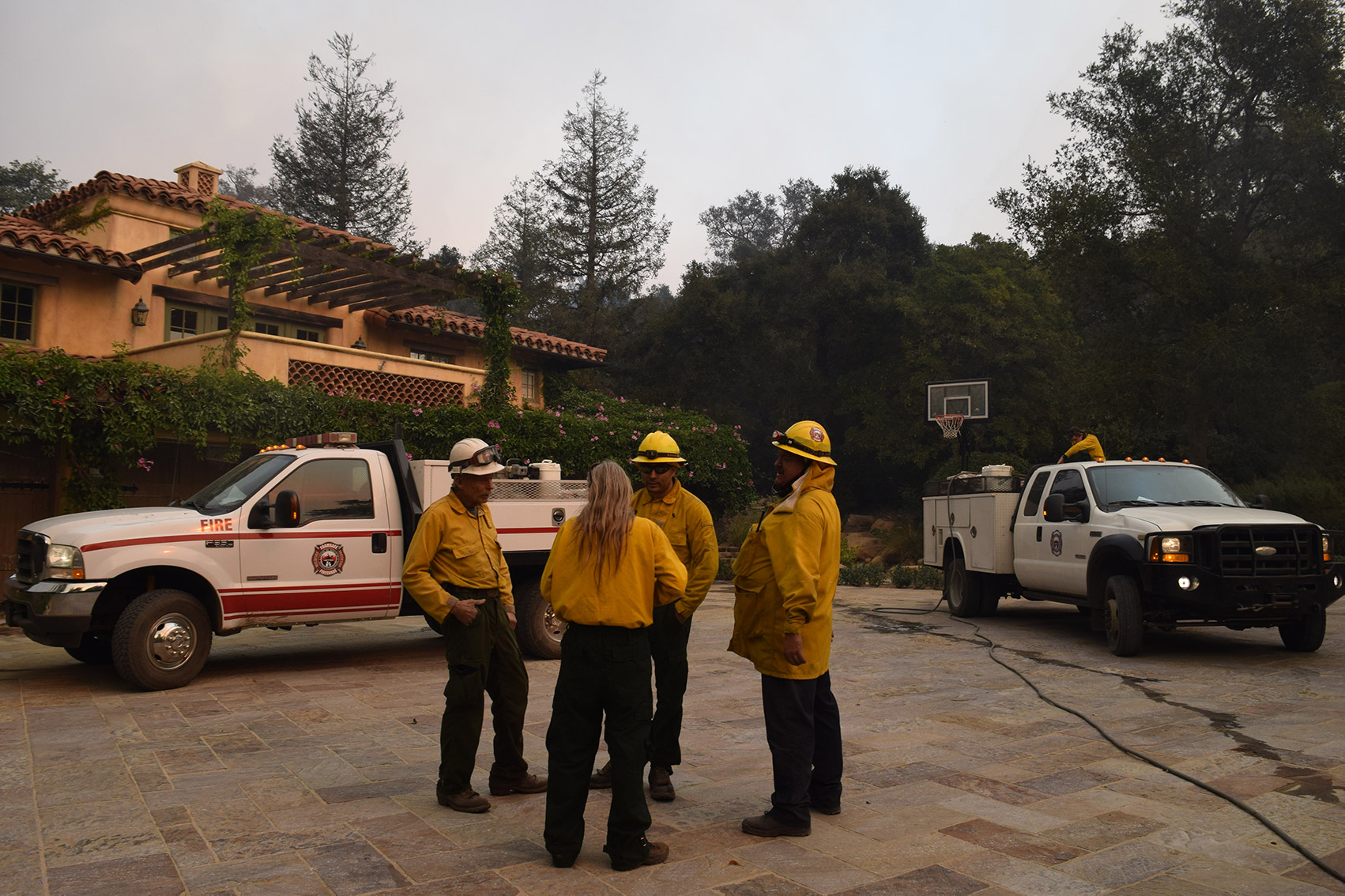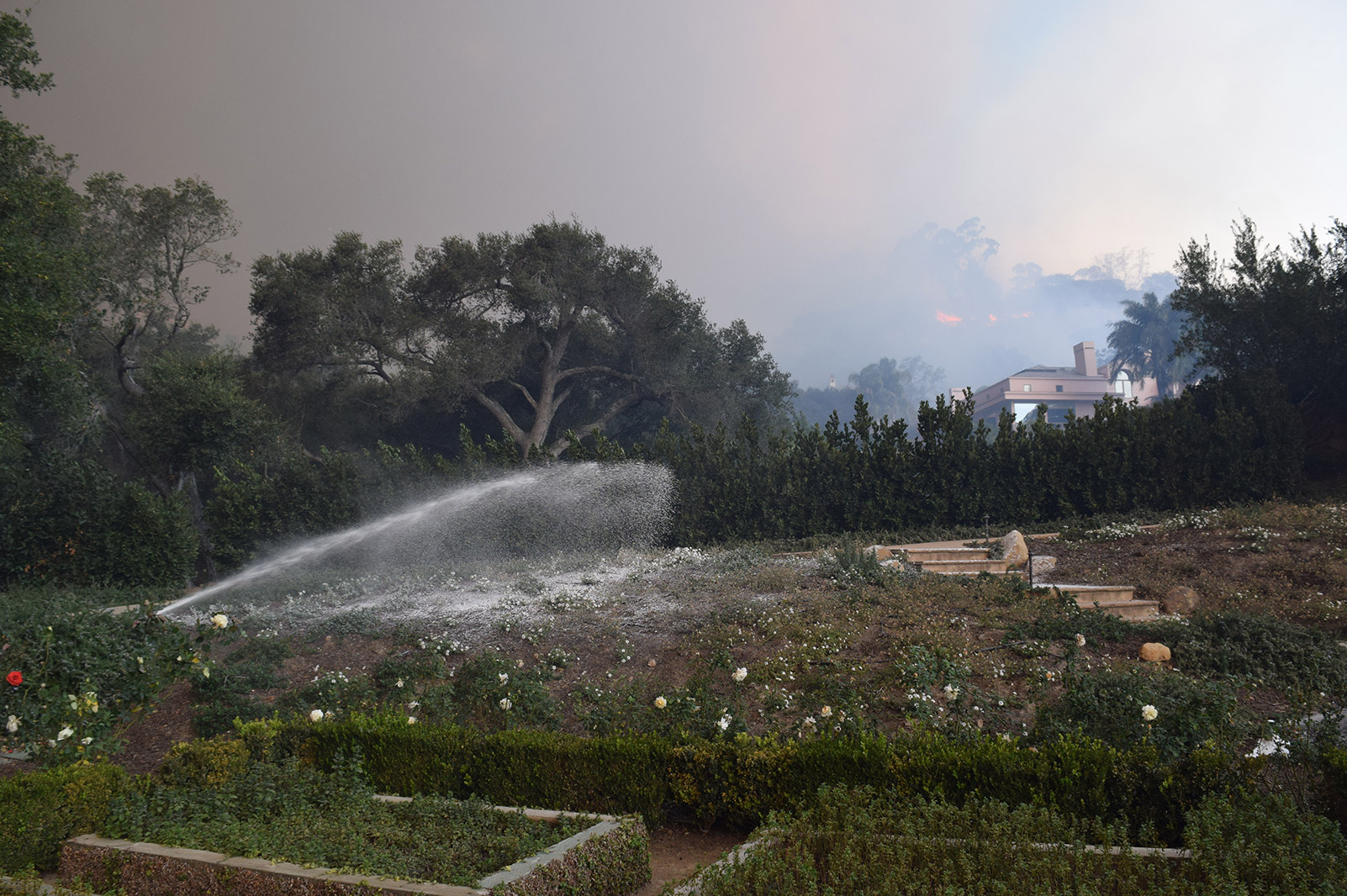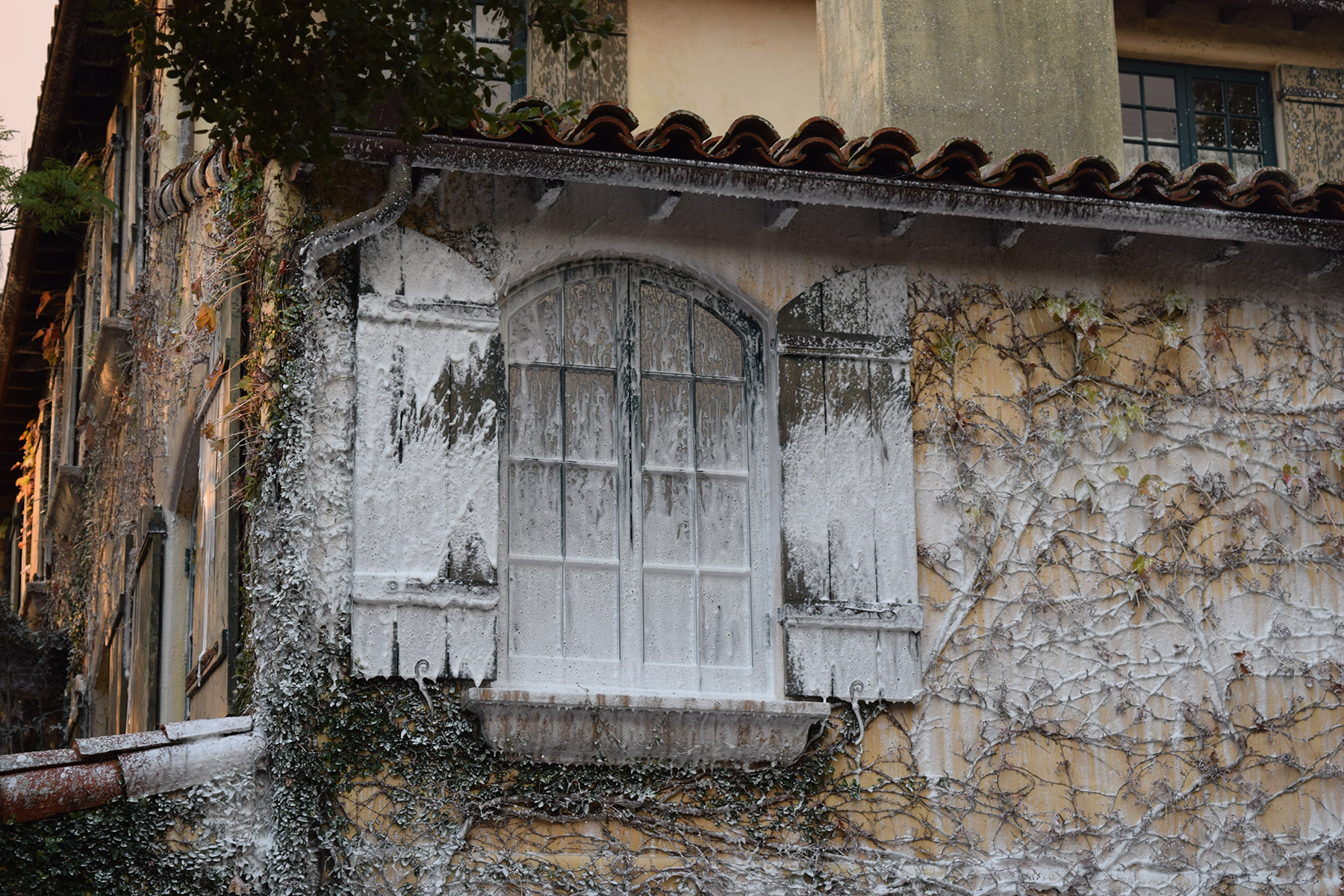
A man in a navy-blue jumpsuit stood on Highway 192 in Montecito next to what looked like a pool-repair truck. One of California’s largest wildfires raged just a few miles away. His long hair tucked behind a workman’s cap did not identify him as one of the 8,300 firefighters battling the 260,000-acre scorcher.
The man in the jumpsuit was not a pool-repair worker; he was in the protection business. He worked for a private firefighting company that was contracted to do “structure protection” for a house nearby, on Buena Vista Drive. It was Sunday, December 10, a week before the Thomas Fire ripped west near multimillion Montecito estates owned by Oprah Winfrey, Katy Perry, Rob Lowe, and Julia Louis-Dreyfus, among others.
The company, Mt. Adams Wildfire, based out of the Sacramento area, is just one of many private companies that have been spotted throughout Montecito to “wrap” expensive homes hidden by lush foliage. The workers coat buildings with white foam or bright pink retardant to douse embers that fly onto roofs or underneath the eaves. They trim back brush and clear debris. Their work is largely preventive rather than active firefighting. “We are not there when the fire is 200 feet away,” said Irene Rhodes, owner of Consumer Fire Products based in Goleta. “That’s how people get hurt.”
Private fire-protection companies are sent by high-end insurance companies, such as Chubb or AIG. Others are hired by individual homeowners. By one estimate, they pay $3,500 per day on top of a $5,000 retainer fee.

Historically, these private companies have been controversial. Private trucks are not tracked by incident commanders, and private employees do not necessarily operate by the same safety standards, public fire officials said privately. They could pose risks if employees were trapped in a danger zone or on blocked roadways being used by municipal fire trucks trying to get out.
Fire officials said private companies have gotten better at coordinating with public agencies in recent years. Still, a clear map of where they are and who they are does not exist.
“I wouldn’t know them if I saw them,” County Fire spokesperson Captain Dave Zaniboni said. “They just show up. They are just doing their own thing, and we don’t really know what that is. We don’t include them in the operational plan.”
Rudy Evenson, a spokesperson for the Thomas Fire Incident Command, said four private companies — AIG Red Zone, Wildfire Defense Systems, Capstone, and Firestorm — are working on the wildfire. Though it is not required, these companies sent personnel to check in at the Incident Command headquarters. But there are no definite figures for the number of engines and employees they have in the area.“I don’t have any information about where they were,” he said, adding, “What they do on private property is up to them.”
Some private companies send liaisons to the daily incident briefings. Rhodes said they tune in their radios to the same channels and check in with the fire’s incident commanders. “It’s different on every fire,” she said.
While some companies have given the private industry a bad name, cooperation and acceptance by the public agencies has grown, several in the fire profession suggested.
One of Rhodes’s products, the Foamsafe FireMaster System, is installed in advance and automatically dispenses a white biodegradable foam on houses when it detects fire a half mile away. Some companies use a red retardant that can harm paint, pets, or plants.

Rhodes said she has 65,000 clients in the 12 western states. In the Thomas Fire, the company has protected about 50 homes, ranches, and businesses. Many houses were on Park Lane, Toro Canyon, East Camino Cielo, and other areas that hugged the fire’s perimeter. As of press time, they were all still standing, she said.
One client, homeowner Carol Kommerstad-Reiche, said during the Tea Fire she was frantically trying to pack up her $11 million Woodley Road home by herself. The service gave her peace of mind.
Consumer Fire Products hasn’t lost a home in 18 years, Rhodes claimed. “I woke up this morning and thought today might be the day,” she said last Saturday, December 16, when deafening 65-mile-an-hour winds rushed the fire west, blackening 20 Montecito homes. (More than 1,300 were deemed threatened.)
Last Saturday, when thick smoke and ash cast a hellish pall over the Santa Barbara coast, some Montecito homeowners who did not have private engines parked in their driveway grew frantic. They called their insurance agents to complain, and others hired structure protection services themselves.
Homeowners are easily spooked when wildfires break out, particularly when they see flames and smoke from backfires set to control the main blaze. “People get very frightened and are very emotional,” said Fran O’Brien, division president of Chubb Personal Risk Services. “They call up and ask, ‘Why isn’t the engine at my house?’”
O’Brien said Chubb agents explained to clients that they surveyed hundreds of houses threatened by the Thomas Fire and prioritized them based on “intel on the ground.” They have 11 engines, each with two employees in them, working the fire, she said.
One Toro Canyon homeowner, Cheryl Giefer, heard about Chubb’s fire-protection services from her neighbors. When the fire first crossed the Santa Barbara County line, her husband called their insurance provider, Allstate, to see if they offered similar services. Shortly after they were evacuated, she received text messages and iPhone photos from private firefighters who showed up to her property. “House is okay now but the fire is at the back on the hill coming down,” the message read.

Other companies send email updates. “We will continue to patrol your property throughout the day and night, staying on high alert for fire threat and taking any mitigation actions available,” read one update from Consumer Fire Products.
David Torgerson of Wildfire Defense Systems said there has been a steady increase in the company’s insurer wildfire programs. He said they provide supplemental support “without replacing any of the public wildfire responders.” We are not “first responders,” he said, adding that the company has maintained a 100 percent safety record on all of the 450 wildfires they have been dispatched to in the last 10 years.
Mt. Adams Wildfire, it turns out, is one of the many private companies the U.S. Forest Service contracts with for extra support. “It saves money,” owner Don Holter said. The private firefighters are not unionized — “No overtime, no retirement,” he said.
Like many essential public-safety services — private prisons and private neighborhood security firms — protecting homes from fire is becoming more privatized. One top fire official working the Thomas Fire asserted that public firefighters “treat everyone the same.” But for $3,500 a day, you can get special treatment.



